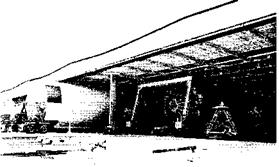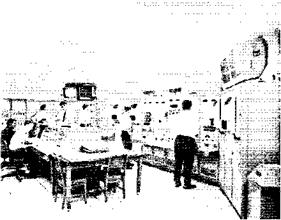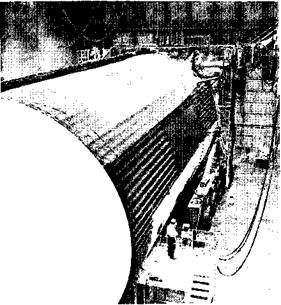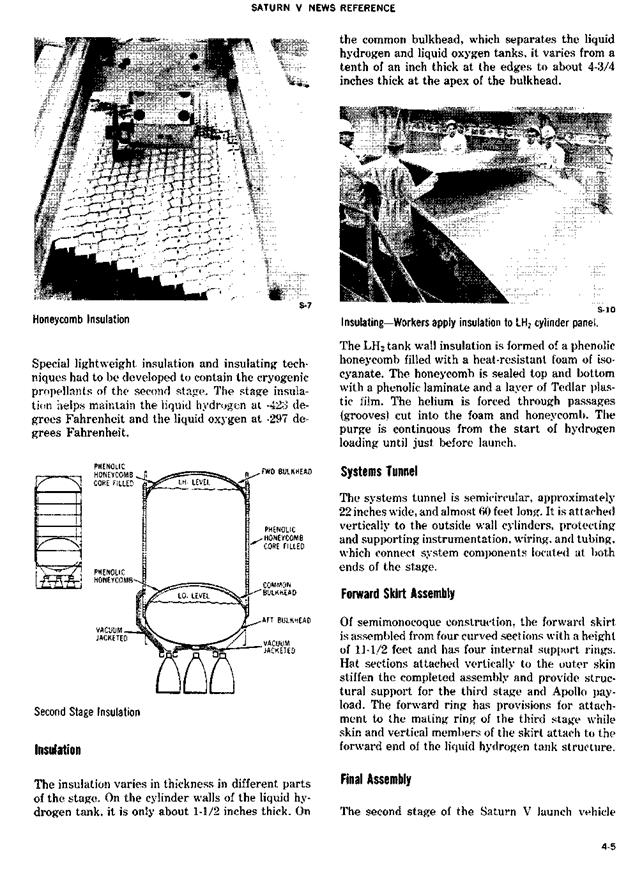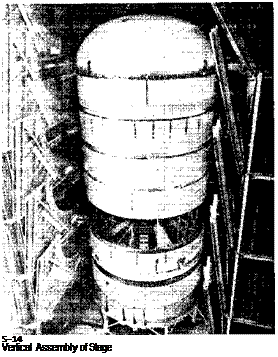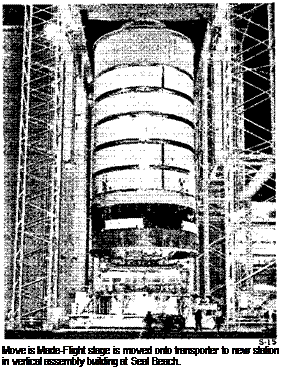At the launch pad, the transporter moves the mobile launcher into position, lowers and locks it onto another set of mount mechanisms. The transporter then moves to the mobile service structure parking area, picks up the service tower, and positions it beside the Saturn V to provide vehicle access for pad operations.
The digital data link, communications circuitry, pneumatic supply lines, propellant lines, environmental controls, and electrical power supply lines are connected.
Power again is applied to the vehicle and the con-
trol and monitor links are verified. Pad testing is held to a minimum. The high hay from which the vehicle was moved remains empty during pad operations.
A spacecraft systems verification test is performed, followed by a space vehicle cutoff and malfunction test. Radio frequency compatibility is established and preparations are made for a final flight readiness test, which involves sequence tests paralleling the actual countdown and inflight operations. Compatibility with the stations of the Eastern Test Range and the Integrated Mission Control Center in Houston, Tex., are verified at this time. Following an evaluation of the flight readiness test, all systems are reconfigured for launch, and all plugs reverified. A countdown-demonstration test is then performed as the final test prior to launch. The countdown-demonstration test consists of an actual launch countdown, complete with propellant loading, astronaut embarkation, etc., with the exception of actual ignition. This test exercises all systems, the launch crew, and the astronauts, and prepares the “team” for the actual operation to follow. This "dress rehearsal" is used to divulge any last minute problems and affords the mission a better chance of success.
Upon completion of the countdown demonstration test, the space vehicle is recycled to pre-count status, and preparations are made for the final countdown phase of launch operations. Normal recycle time between completion of the countdown demonstration test and beginning of launch countdown is 48 to 72 hours.
Propellant loading of the Apollo spacecraft is performed prior to launch day. Aerozine 50 is the fuel and nitrogen tetroxide, the oxidizer. Also prior to launch day, hypergolics for the third stage reaction control system are loaded and ordnance connected. Loading of the cryogenic propellants for the launch vehicle begins on launch day at approximately T-7 hours. (The kerosene is loaded one day before launch.)
Liquid oxygen loading is begun first. The tanks are precooled before filling. Precool of one tank can be accomplished concurrently with the fill of another. Loading is started with the second stage to 40 per cent, followed by the third stage to 100 per cent. The second stage is then brought to a full 100 per cent followed by loading the first stage to 100 per cent. This procedure allows time for the liquid oxygen leak checks to be performed prior to full loading of the second stage. Liquid oxygen is pumped at a flowrate of 1,000 gallons per minute for the third stage. For the second stage, the tank rate is 5,000 gallons per minute, and the first stage tank flowrate is 10,000 gallons per minute.
Liquid hydrogen loading is initiated next, beginning with the second stage to 100 per cent. Loading of the third stage liquid hydrogen is last. Liquid hydrogen is pumped to the second stage at a rate of 10,000 gallons per minute, and to the third stage at a rate of 4,000 gallons per minute. Topping of cryogenic tanks of the launch vehicle continues until launch. Total cryogenic loading time from start, to finish is 4 hours and MO minutes.
At approximately T-90 minutes, after propellants are loaded, the astronauts enter the spacecraft from the mobile launcher over the swing arm walkway.
LAUNCH
During the remainder of the countdown, the final systems checks are conducted.
Launch vehicle propellant tanks are then pressurized. and the first stage engines ignited. During the thrust buildup of the F-l engines, the operation of each of these engines will be automatically checked. Upon confirmation of thrust OK condition, the launch commit signal is given to the holddown arms and liftoff occurs.
Assembled Vehicle—The Saturn V facilities vehicle, the 500F, arrives at Launch Complex 39A.
I SATURN V NEWS REFERENCE
![]()











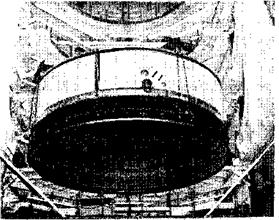


 The SS/FM system is reserved for pertinent research requirements. Vibration and acoustical data needed for manned flight development will be transmitted by this system.
The SS/FM system is reserved for pertinent research requirements. Vibration and acoustical data needed for manned flight development will be transmitted by this system.
